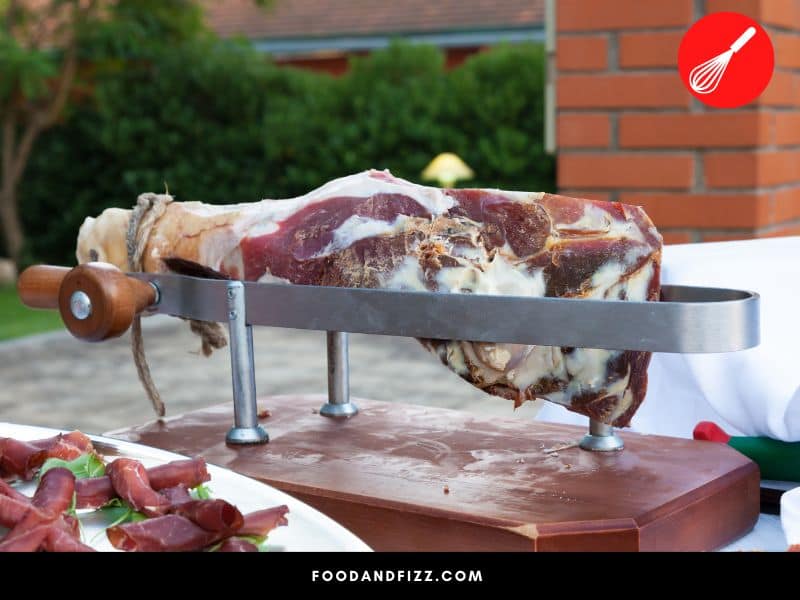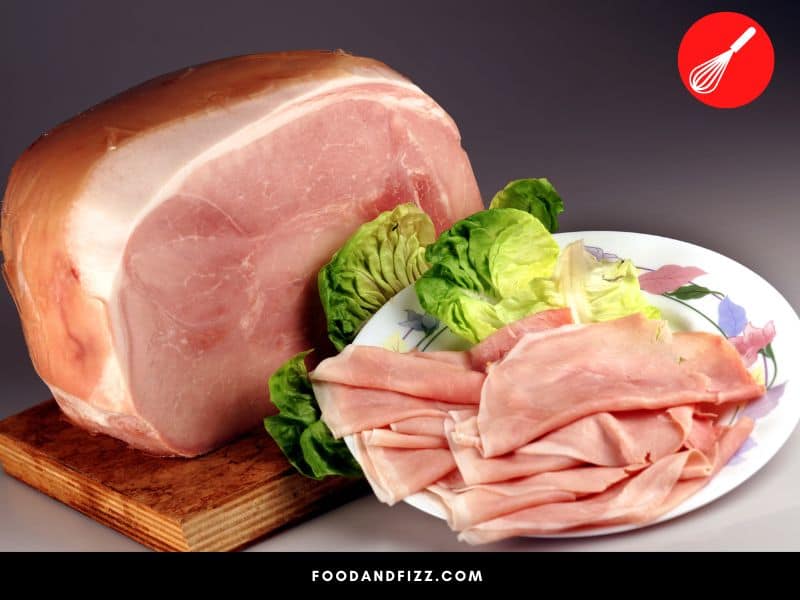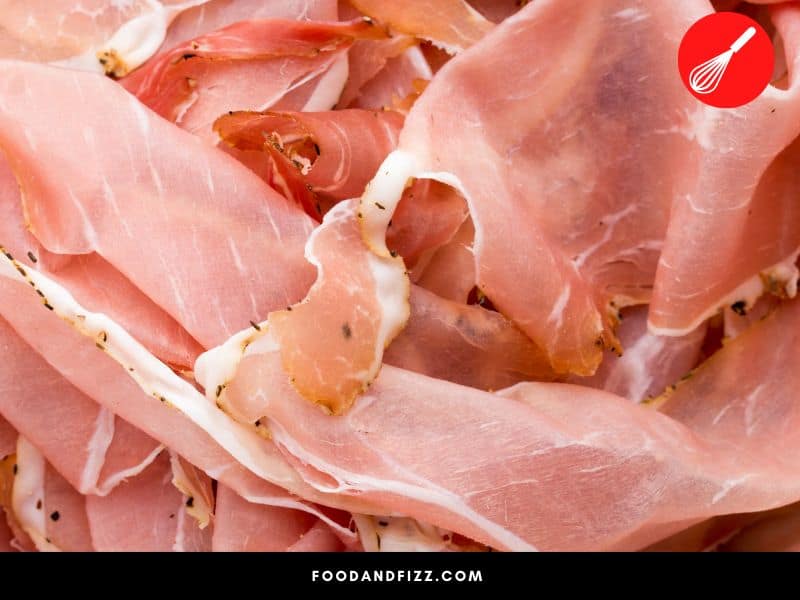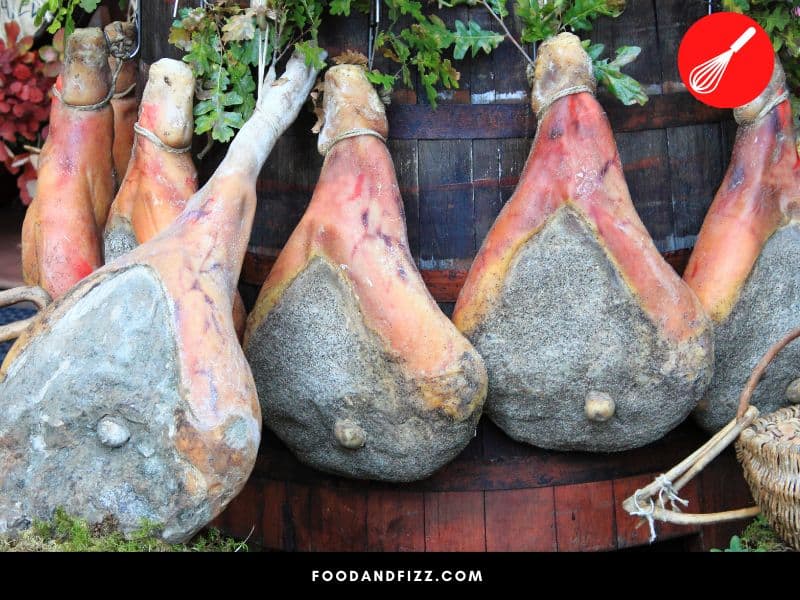The terms Parma ham and prosciutto are often used interchangeably, both referring to thin, Italian-style cured pork meat. But do they actually mean the same thing? Is there a difference between Parma ham and prosciutto?
Parma Ham vs Prosciutto – What is The Difference?
Prosciutto is the general term for ham in Italian but common usage of the term pertains to thinly sliced, uncooked and unsmoked dry-cured prosciutto crudo and similarly prepared hams. Parma ham is a specific type of prosciutto crudo from Parma or the region of Emilia-Romagna in Italy.

The Difference Between Parma Ham and Prosciutto
The terms Parma ham and prosciutto are used similarly so it is easy to conclude that they are just referring to the same thing. That would not be totally inaccurate, but they have a few notable differences worth knowing about.
Prosciutto is a term that is usually used to refer to thin slices of raw, cured pork from Italy.
How is it different from Parma ham?
Specific vs Generic Term
Parma ham is a specific term pertaining to the dry-cured ham from the Parma region of Italy. Prosciutto is a more general term referring to prosciutto made in any region.
This means that Parma ham and prosciutto refer to the same thing, except that it can only be called Parma ham if it is made in or came from the region of Parma.
If the prosciutto came from a different region or is made in a different area, it cannot be called Parma ham.
To put it simply, all Parma hams can be called prosciutto, but not all prosciutto can be called Parma ham.
Protected Designation of Origin Status of Product
Parma ham is a specific type of prosciutto crudo from the Emilia-Romagna region in Italy that has a PDO status (Protected Designation of Origin). Not all prosciutto crudo has this designation.
Curing Ingredients
Prosciutto crudo can be cured using a variety of ingredients, and that can include nitrates or nitrites that usually boost the red hue of cured meats.
Parma ham, however, only uses sea salt. It cannot have any artificial preservatives or any other added ingredients apart from Italian pork and salt.
What is Prosciutto?
The term “prosciutto” in Italian, simply means ham. It may pertain to either prosciutto crudo or prosciutto cotto. We’ll look at the differences below.
Prosciutto Crudo
Prosciutto, in common usage, usually pertains to prosciutto crudo. Prosciutto crudo is unsmoked ham that is dry cured and matured.
It is typically served as an antipasto, thinly sliced alongside fruits like melons and figs or vegetables like asparagus. It can also be wrapped around breadsticks.

How is Prosciutto Crudo Made?
The process of making prosciutto crudo can take several years of curing and drying, and is done in a carefully controlled environment.
Prosciutto is specifically made from the hind legs or thighs of the pig. The hind legs are first cleaned and then salted to draw out the moisture and remaining blood from the meat. This process is done over a period of weeks, where it is slowly and gradually pressed to properly drain.
After this, the pork legs are washed several times to remove the salt and other impurities. It is then seasoned again, often according to secret family recipes that have been passed on for generations, and then hung and allowed to dry and age in a dark environment with controlled temperatures for up to 36 months.
The exact time depends on the producer, and depends on the climate of the region. A cool climate is usually required for the best results.
Sometimes, prosciutto crudo may be salted and cured with nitrites to achieve the desired color and flavor, but certain types of prosciutto like Prosciutto di Parma or Parma ham, are only seasoned with plain sea salt.
Prosciutto Crudo’s unique flavor and texture are due to the interaction of salt and air with the meat, and the chemical reactions that take place over time. These three elements are what give prosciutto crudo that desirable flavor.
Prosciutto Cotto
Prosciutto cotto is ham that is brined, seasoned, and then cooked. It is lesser known compared to its dry-cured sibling, but it is said that when sourced and produced to high quality, it can hold its own compared to its most popular sibling.
It is bright pink in color and has a lighter flavor than prosciutto crudo.

How Is Prosciutto Cotto Made?
The legs of the pig are deboned and defatted and a brine made of herbs, spices, and seasonings is infused into the pork meat.
This brine is massaged into the meat for even distribution. It is then slowly cooked with the skin on to retain its moisture. It is also cut and served into thin slices. Prosciutto Cotto typically has less salt compared to American ham.
What is Parma Ham?
Parma ham is a kind of prosciutto crudo that is made in a region of Italy called Emilia-Romagna.
It is a type of prosciutto with PDO status or Protected Designation of Origin, which means that Parma ham can only come from this region and can only be produced from pigs bred in this area and made in a way specific to this region.
The landscape of the region contributes to the unique taste and quality of to the product that is hard to replicate elsewhere.
Parma ham is silky, almost creamy in texture, deliciously salty and savory, and has a tinge of sweetness to it, which makes it one of the most prized types of prosciutto.
How is Parma Ham Made?
Parma ham is made in a very specific way, and for it to receive the stamp of approval from the Consorzio del Prosciutto di Parma for it to be called Parma ham, it has to meet certain standards.
That doesn’t mean, though, that all types of Parma ham taste the same. The specific type of pig and how long it is aged all play a role in creating different taste profiles.
Parma ham is typically only made with 4 ingredients: Italian-born and bred pigs, sea salt, air, and time. The process is a long one, and after having a taste of these wonderful strips of cured meat goodness, you would say the painstaking process that goes into making it is surely worth the trouble.

Process of Making Parma Ham
1. The Pork Legs Arrive
From the moment the pigs are born, they are carefully monitored and cared for to ensure that they are healthy and fed a healthy diet. The pigs used for Parma ham must be Italian-born and bred.
Prosciutto di Parma producers receive pork legs from authorized farms, weighing, on average, about 33 lbs (15kg). This happens usually on a weekly basis.
2. Salting the Legs
A highly trained expert and master of salting called a maestro salatore, salts the meat using sea salt. It is then refrigerated at temperatures between 33 to 39°F (1-4°C) for about one week. After this, it is re-salted again and allowed to absorb for another 15-18 days.
Nitrates and nitrites are not used in this process, unlike other types of cured meat and other prosciuttos. Sea salt is the only one that is used in curing Prosciutto di Parma.
3. Pork legs Are Allowed to Rest
The pork legs are hung in rooms where the temperature and humidity are controlled, and they are allowed to rest for a period of 2-3 months.
4. Ham Is Washed And Dried
The pork legs are then washed to remove excess salt and any impurities and left to dry for a few days. After drying, they are hung on frames in a room that is well-ventilated.
Sometimes, the large windows in these rooms are opened and the air is allowed to come in, especially if the air outside is favorable. The humidity levels in the air is important.
This process allows the ham to gradually dry, and most experts believe this is the period where the flavor of the ham really develops, and is thus a crucial part of the process. This period lasts about 3 months.
5. Pork legs Are Greased and Covered in Lard
At the end of the 3-month drying period, the external skin of the ham will have dried and hardened. The next step then entails covering the outside skin with a mixture of salt and lard, so that the outside of the ham does not dry out too fast.
6. Final Stage of Curing
The hams are then transferred to a room or cellar with less light and air. They are left to hang on the racks until the final curing process is completed. During this period, the ham further develops in flavor and texture.
7. Quality Check and Branding
The law requires that from first salting, Parma ham is aged and cured for a minimum of 1 year, with some even going as long as 3 years.
After this period is over, the quality of the ham is checked by experts. A needle is inserted into 5 different points of each leg of ham and from the scent absorbed in this needle, experts are able to tell whether the process of making Parma ham has been carried out correctly.
If the ham passes the test, it is then branded and certified with the official logo or seal. This seal also bears details of the producer so that the Parma ham can be traced back to the producer.

So there we have it, the complete steps in the production process of Parma ham. After learning about these meticulous steps taken in producing Prosciutto di Parma, it is no wonder then that it is so delicious and so well-loved and valued by many.
Conclusion to Parma Ham vs Prosciutto
Parma Ham and prosciutto both refer to pork that has been aged and dry-cured, however, they have important differences.
Prosciutto is a general term for Italian cured pork, while Parma ham refers to a specific and distinct type of prosciutto that is processed and produced in the Parma region of Italy.
Parma ham is cured using only sea salt, while other types of prosciutto may be cured using nitrates and nitrites.
Parma ham is a product with Protected Designation of Origin status, while other types of prosciuttos do not necessarily have that.
The differences in the usage of terms are useful to note the next time you encounter the wonder that is prosciutto.
Frequently Asked Questions to Parma Ham vs Prosciutto
Is Parma Ham Healthy?
Parma ham is healthier than most cured meats because it is natural and free from preservatives and has only two ingredients: Italian pork and salt. It does not use or contain nitrates and nitrites and can be consumed in moderation as part of a healthy diet.
Is Parma Ham Raw?
Parma ham is a dry cured pork product that is aged and matured over time using sea salt, air, and time. It is technically raw, but the stringent curing and maturing process makes it safe to consume without cooking.
Is Prosciutto the Same As Parma Ham?
Parma ham is a kind of prosciutto, but it is one that is specifically produced in a region of Italy called Emilia-Romagna.

